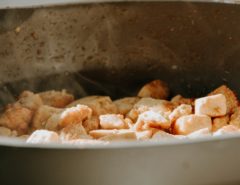By Alexander J. Taylor
I love Fall. For. Real. I love the feeling of an autumn wind; the myriad of reds, yellows, oranges; the times that remind me of being with loved ones and friends, even during the pandemic; and the time where it is a perfect opportunity to crank up the oven and make some fresh-baked goods. From pumpkin cinnamon rolls to blackberry cobbler, to the ever-present smell of apple pie, autumnal foods remind me of simpler times and cozy memories. In particular though, one such memory was on repeat this entire year, as I noticed a trend emerge in my social media. Perhaps you happen to remember, near the early-set of stay-at-home orders (April-ish), a specific collection of bread making its way onto your social media feed. The ruler of tanginess, the five-star general of grilled cheeses, the starter to all starters (Sorry, I had to): Sourdough Bread!
Sourdough has been around for ages, but recently spiked in popularity from February until September, according to Google Trends (see below). Specifically, sourdough-type bread has been traced back before 3,700 BCE 1. However, the actual origin is likely several thousand years before 3,700 BCE! There’s just something about sourdough that envelopes the consumer in a fluffy, tangy, yet sweet bite. This trend has started becoming more and more well known, as recipes include sourdough into various dishes and products! So, let’s dive into what exactly sourdough is, the microbial world that dominates sourdough, some really cool research going on, and how YOU can add to it!

Sourdough, by definition, is a fermented bread product from natural or “wild” yeasts and lactic acid bacteria. Until humans had cultivated specific yeasts and bacteria, dough would come in contact with microbes in the surrounding environment. Naturally-occurring yeasts and bacteria can be found in the flour, on your hands that work the dough, and even the air around you. Specifically, two types of microbes are extremely important to yielding sourdough, yeasts and lactic acid bacteria. Without yeasts, lactic acid bacteria would not be able to grow well in the dough. Without lactic acid bacteria, the sourdough would just be normal bread without its mellow, sweet, tang to it! You can even try this out yourself: take a bowl and mix flour and water in it. You’ll make a pasty, goopy substance called a papier-mâché paste. This bowl will immediately be inoculated by microbes. While you cannot see it at first, they are metabolizing the sugars in the flour and starting the fermentation process. This will lead to a bubbling, sticky, and gelatinous flour mixture that will have a slightly sour odor.
So where exactly does it all start? Well, with the starter! A starter, also known as a pre-ferment or “mother dough,” is a mixture of microbes that ferment, some nutritious medium for the microbes, and may either be “wild” or packaged “baker’s yeast.” Most of these starters can be stored in containers, like jars or pots, so long as they are given fresh flour and water from time-to-time. Starters are very tricky to handle, requiring time, attention, and patience. It is highly recommended to find a local bakery or restaurant that frequently uses sourdough and kindly ask if they would be willing to lend you some starter.

If not, you can attempt your own starter by combining 5 oz of all-purpose flour and 5 oz of water in a bowl. Stir vigorously until it becomes a sticky, viscous dough. Place the container somewhere in your kitchen and cover with a clean kitchen towel and some rubber bands around the side! Leave for 24 hours around 70℉ to 76°F and check on it the next day. Check the starter. If there are small bubbles, then the yeasts have started fermenting; it should smell yeasty and sweet. Add more flour and water (again equal weight amounts) to “feed” the starter. Stir again and let sit for another 24 hours. If you want normal bread, you could stop there and use that in typical bread recipes. Check the starter again, it should have large bubbles that have created spaces in the dough. If the dough does not feel as sticky, it just needs one more day! On Day 4 or 5, the starter should have doubled in bulk size, feel loose and moveable, and smell a little sour and yeasty. If you want to use it, you should do so immediately; if not, you can discard around half of it, feed it, and use it within a week’s time. It is possible to place the starter in the fridge, but some yeasts and lactic acid bacteria do not ferment as well at cold temperatures. Now you have your own starter to use for any sourdough recipes you want!
Microbially, there is a huge world of sourdough that has still yet to be explored. While most breads are fermented by “active, dry yeasts” (Saccharomyces cerevisiae), there are several other associated yeasts like Saccharomyces exiguous, Candida milleri, and Candida humilis. These yeasts have also been found in kefir and are typically acid-tolerant. As for the lactic acid bacteria, there are three major types: Homofermentative, facultative heterofermentative, and obligate heterofermentative. Each of these can be understood as what sugars they can metabolize, what biochemical pathways they use, and the products produced from those pathways. Homofermentative metabolize hexose (six-carbon monosaccharides) into lactic acid and cannot tolerate oxygen. Facultative heterofermentative metabolize hexoses into lactic acid, pentoses (five-carbon monosaccharides) into acetic and lactic acid and can metabolize with or without oxygen being present. Obligate heterofermentative metabolize the same as facultative heterofermentative but produce carbon dioxide (bubbles) from hexoses.

Image used courtesy of Dr. Anna Waller “Roasted Garlic and Rosemary Sourdough”
Overall, there are many kinds of microbes that are involved in sourdough fermentation and there are many still to be found. Just last year, a physicist and Xbox inventor, Seamus Blackley, and a crew of researchers made up of a University of Iowa biologist, Richard Bowman, a University of Queensland Egyptologist and archaeologist, Serena Love, and Boston and Harvard’s Museum of Fine Arts revived a 4,500 year old yeast from Ancient Egyptian pottery. By using a flour variety similar to that which the Ancient Egyptians used, they were able to revive AND bake multiple loaves of ancient grain, ancient sourdough breads. On another note, researchers at North Carolina State University are collecting samples from all over the world and need YOUR help! They have set up a really amazing and explanatory experiment to create your own starter, observe it, record any observations, and then answer a short online questionnaire! If you are able to, they then want to characterize the different types of flours or methods that you use to make your starter. So far, they have over 500 different samples and have started looking for the specific microbes associated with these starters. They have even collected a starter that is almost 300 years old! I cannot urge you enough to please contribute what you can to this experiment. Get your friends and family involved and contribute to the science of sourdough.

Image used courtesy of Dr. Anna Waller “Crusty sourdough with a fluffy, bubbly center!”
If you also haven’t gotten a chance to do so, I would suggest that you look at the amazing sourdough bread creations on your social media of choice. Instagram has a wide melange of gorgeous looking sourdoughs. From focaccia to bagels to homemade blueberry sourdough pancakes, I can only hope that this delectable, tangy mystery has got you thinking about the microbes in your food. It is due to their help that we are able to have such a plethora of creative flavors and products. And as the weather gets colder, I hope those ovens are turned on and the sweet aroma of fresh baked sourdough courses through your kitchen. I know I cannot wait to try some pumpkin sourdough cinnamon rolls...
References:
- Gaenzle, Michael (1 April 2014). “Sourdough Bread”. In Batt, Carl (ed.). Encyclopedia of Food Microbiology (2nd ed.). Academic Press. p. 309. ISBN 978-0123847300.

A.J. Taylor | Linkedin
SMF Blog Writer
A.J. earned his degree in Biochemistry from Judson University and his Master’s in Food Science and Human Nutrition from the University of Illinois at Urbana-Champaign. His research then focused on Listeria monocytogenes, but has now transitioned into a Ph.D. program at UIUC in the hopes to discover more about the cocoa bean fermentation process using genomic, bioinformatic, and biochemical tools to define chocolate flavor from start to finish. A.J. emphasizes on the importance of science communication and loves to discuss multiple topics in the Food Science realm. A.J. is also an avid gamer from board games to video games, as well as a podcast-lover, if you have any recommendations, he is all ears!






Leave a Reply